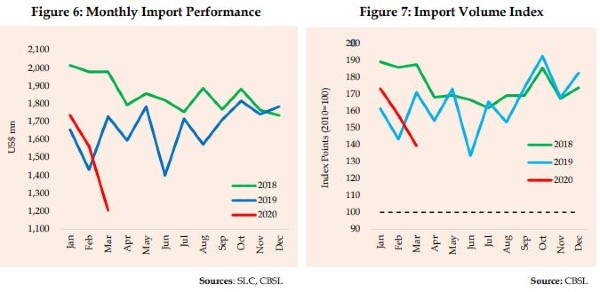Sri Lanka trade deficit narrows in March 2020
3 min read
According to the latest external trade data released by the Central Bank, country’s trade deficit had narrowed in March 2020 as imports fell more than the decline in exports.
The COVID-19 pandemic and the imposition of a partial lockdown in Sri Lanka in the second half of March 2020 affected external sector performance in March 2020.
Breakdown in supply and demand chains along with the interruption of domestic production processes resulted in a notable decline in merchandise exports as well as merchandise imports.
However, with a greater decline in the expenditure on imports compared to the decline in earnings from exports, the trade deficit narrowed over the same period in 2019.
The deficit in the trade account narrowed in March 2020 to US dollars 549 million, from US dollars 592 million in March 2019, as the decline in imports in value terms exceeded the decline in exports.
However, on a cumulative basis, the trade deficit widened to US dollars 1,853 million during the first three months of 2020 from US dollars 1,661 million in the corresponding period of 2019.
Meanwhile, terms of trade, i.e., the ratio of the price of exports to the price of imports, improved by 25.7 per cent (year on year) in March 2020, due to the increase in export prices and decline in import prices.
Performance of Merchandise Exports
Earnings from merchandise exports declined significantly, on a year on year basis, by 42.3 per cent to US dollars 656 million in March 2020, reversing the marginal growth recorded in February 2020. Disruptions to domestic production processes, disruptions to export related services due to the imposition of curfew and disruptions to both domestic and global supply and demand chains due to the outbreak of the COVID-19 pandemic were the main reasons for this sharp decline in the earnings from exports.
Accordingly, all major exports sectors; agricultural, industrial and mineral exports, recorded significant contractions in March 2020. Major export products such as textiles and garments, tea, rubber products, gems, diamonds and jewellery, machinery and mechanical appliances, seafood and coconut mainly contributed to the decline in export earnings. However, earnings from minor agricultural products exports recorded a growth during the month.
The export volume index in March 2020 declined by 45.1 per cent, while the export unit value index improved by 7.3 per cent, indicating that the decline in exports was driven entirely by lower volumes when compared to March 2019.

Performance of Merchandise Imports
Expenditure on merchandise imports declined notably, on a year on year basis, in March 2020 by 30.3 per cent to US dollars 1,205 million, reversing the increasing trend observed since December 2019. The selective import clearing process followed by the Sri Lanka Customs (SLC), prioritising essential consumer items and the disruption to other import related services due to the imposition of curfew, disruptions to global supply and logistic chains, lower commodity prices following the COVID-19 outbreak were the main reasons for this unprecedented decline in the expenditure on imports. In addition, urgent measures taken by the government and the Central Bank in March 2020 to ease the pressure on the exchange rate and to prevent financial market panic due to the COVID-19 pandemic, including the suspension on facilitating the importation of motor vehicles and non essential consumer goods, also contributed to this decline in import expenditure.
Accordingly, all major import sectors; consumer, intermediate and investment goods, declined in March 2020. The expenditure on fuel declined, led by lower average import prices of crude oil (US dollars 37.7 per barrel, on average, in March 2020), refined petroleum and coal. Volumes of fuel imported also declined, except crude oil. The expenditure on machinery and equipment, textiles and textile articles, building material, fertiliser, chemical products also recorded significant declines. In addition, expenditure on non food consumer goods such as personal vehicles, telecommunication devices and home appliances imports, which were subject to import restrictions also recorded reductions in March 2020. However, expenditure on the importation of essential consumer goods such as wheat, vegetables (mainly big onions and potatoes), sugar, spices (mainly chillies) and seafood (mainly canned and dried fish) increased in March 2020. In addition, import expenditure on base metals (mainly iron and steel) and rubber and articles thereof categorised under intermediate goods also increased in March 2020 compared to March 2019.
Both the import volume index and the unit value index declined by 18.4 per cent and 14.6 per cent, respectively, in March 2020, indicating that the decrease in imports was driven by both lower volumes and lower prices when compared to March 2019.

